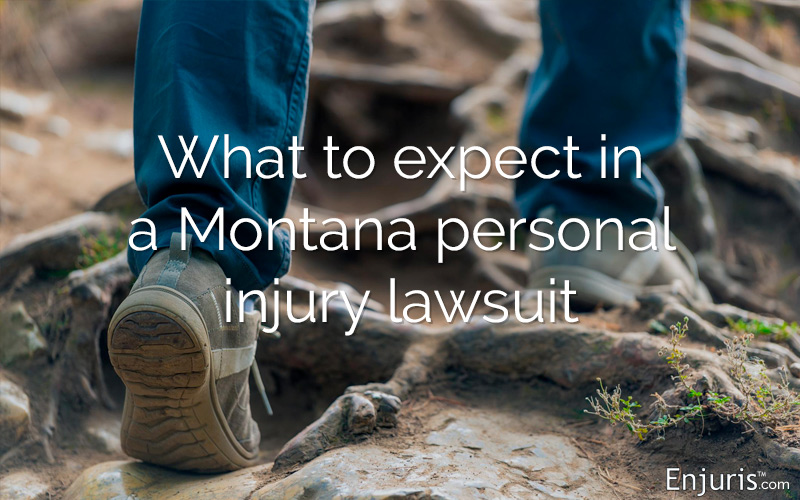How to file a personal injury lawsuit in Montana
There’s no one-size-fits-all approach to filing a lawsuit in Montana. There are some aspects to the lawsuit process that are required and necessary, but there could be variations depending on what type of case you have.
Here, we’ll walk you through the process of being a plaintiff in a personal injury lawsuit in Montana.
Step 1: Do you have a claim?
You’ve been injured.
Was it a car accident? The result of using a defective product? Medical malpractice? A slip-and-fall caused by someone’s negligence? An injury or illness that happened at work? Or a non-economic injury like damage to your reputation?
These are just a few examples of personal injuries that give rise to lawsuits.
First, you should know that lawsuits have expiration dates in Montana. The statute of limitations is the amount of time allowed in which to file your claim. Here’s a general overview:
| Montana Statutes of Limitations | |
|---|---|
| Personal injury | 3 years |
| Wrongful death | 3 years |
| Defamation | 2 years |
| False imprisonment | 2 years |
| Product liability | 3 years |
| Debt collection | 3 years |
| Fraud | 2 years |
| Loss or damage to property | 2 years |
| Legal professional malpractice | 3 years from discovery, 10-year maximum |
| Medical malpractice | 3 years from discovery, 5-year maximum |
| Contracts | 8 years for written, 5 years for oral |
The clock begins to run either on the date of the accident or on the date of diagnosis of an injury or illness. It depends on when a reasonable person should have known that an injury occurred. There are very few exceptions if you miss the statute of limitations for filing a case. If you don’t file a lawsuit within the time allowed by law, the defendant can have the case dismissed on that basis.
If you know you’re within the statute of limitations, think about the injury, itself.
One of the first things your personal injury lawyer will do is establish causation and fault (also called “liability”). The case will hinge on whether someone was at fault, and if that person’s actions caused you to be injured.
When you meet with your lawyer for the first time, be prepared to tell them how the accident happened and the nature of your injuries.

A worksheet to prepare for your first meeting with a personal injury attorney – what to bring, what they'll ask
Download in PDF format

Worksheet with questions to ask a personal injury attorney to help determine if he or she will be a good fit for your case
Download in PDF format
Step 2: Pleadings
Once you’ve hired an attorney, they’ll file a pleading to the court that states your case. The plaintiff’s document is called a complaint. The complaint has four parts:
- It sets forth the events that led to the injury.
- It describes the injury and what you (the plaintiff) expect to recover as compensation.
- It establishes a legal basis for why the defendant is responsible for your injury.
- The demand tells the defendant how much money you hope to recover.
The defendant will respond in a pleading called an answer. This document is the defendant’s opportunity to present a defense or explain why they’re not liable, in their view. It’s also sometimes used in a counterclaim, which is when the defendant tries to hold the plaintiff responsible for some or all of the incident in question.
| Should I accept a settlement offer? |
|---|
| After a complaint is filed, there’s always the opportunity for you or your lawyer to offer or accept a settlement in a personal injury case. A settlement is a sum of money that the defendant is willing to pay as compensation in exchange for your dropping the case. It might be the full amount that you demanded as recovery, or it could be a portion of the damages.
A settlement has pros and cons for both the plaintiff and the defendant. It’s rare for a defendant to immediately offer the full amount of damages that you request. Usually, there’s negotiation before a settlement is reached. The clear benefit to both parties is that a settlement means they no longer need to endure a lengthy and costly litigation process. It provides immediate financial relief to you, allowing you to then “move on” to recover physically and emotionally from your injury. You would also receive the funds to pay for ongoing treatment if necessary. If the defendant is a well-known person in the community, or if it’s a business, a settlement can mean less time for the media to cover the case. Sometimes, making it “go away” and avoiding negative publicity associated with the lawsuit makes it worthwhile to a defendant to meet your demands. Often, the terms of a settlement are sealed, which means no one other than the parties will know how much was the agreed upon amount. If you have a case that seems like it would have a good outcome, it might be worthwhile to hold out for court if the defendant isn’t offering the full amount of the demand. This involves risk, as no lawyer (no matter how experienced) can correctly predict the perception of a judge or jury 100% of the time. But your lawyer will give you a professional opinion as to whether the settlement offer is a good one, if you should continue to negotiate, or if you should let the court decide. Your lawyer is required to notify you of any settlement offer and will advise whether they think it’s a good one, but the choice is ultimately yours if you want to accept. |
Step 3: Discovery
If a settlement agreement cannot be reached, the case moves on to the next phase. Discovery is the process where both parties gather evidence that supports their arguments. This can take months or years to complete. Evidence can be gathered from:
- Documents including police records, medical records, and other materials
- Depositions or written interrogatories of parties and witnesses
- Expert investigations of the scene or other aspects to the case
- Written requests for admissions of fact
Throughout this process, there are legal filings that might ask the court to act in various ways. The courts can be asked to amend or dismiss parts of the case, clarify issues, or make a ruling.
Step 4: Trial
In preparation for trial, each party submits a brief to the court that sets forth what its arguments will be and what evidence it will present at trial. In Montana, a civil case can have a “petit jury” of 6-12 people. The jury’s role is to listen to the evidence, decide whether the defendant injured the plaintiff, and determine what the compensation will be.
Once the court has summoned people qualified to be jurors, they will participate in a process called voir dire. In this process, the lawyers for both sides are allowed to question each prospective juror and exclude those who they think can’t fairly decide the case. The jurors might be asked questions about their prejudices, whether they know any of the individuals involved in the case, whether they have information about the case, or other things. A lawyer can exclude a juror without offering the court a reason.
How cases are presented at trial
At the beginning of trial, the plaintiff’s lawyer and the defendant’s lawyer each present an opening statement that outlines their clients’ arguments.
The plaintiff has the first opportunity to present their case. This includes presenting any witnesses and evidence it plans to use as proof. The defense is allowed to cross-examine the plaintiff’s witnesses. Once the plaintiff rests, the defendant is called to make their case using witnesses and evidence.
When the defendant’s case is complete, the plaintiff’s attorney has the opportunity to make a rebuttal, which means it can offer additional evidence that’s used to disprove what the defendant has presented.
Finally, each side makes its closing argument and the trial concludes. If it’s a jury trial, the judge will issue any relevant instructions before jurors begin deliberations. If it’s a bench trial (only a judge), the judge will begin their own decision making process.
And then you wait.
The judge or jury will take however long it requires to make a decision. It could be minutes, hours, days, or even weeks, depending on how complicated the evidence is and how the jury works together to reach agreement.
Finally, the judge or jury will reach a verdict (decision) in the case.
Step 5: Appeal
If you’re unsatisfied with the verdict, you can choose to challenge it through the appeals process. That means that you’re going to present your case to an appellate court that will review the proceedings. The appellate court can either affirm the lower court’s decision or reverse it, or it could order a new trial.
Should you file a lawsuit?
Only you and your lawyer can decide if a lawsuit is the right course of action in your situation. If you do decide to move forward, there will be plenty more decisions as you navigate the process. You need to find a lawyer who understands the case and with whom you feel comfortable. This list of Montana personal injury lawyers can help you get started finding an attorney with the expertise, compassion, and motivation to help you achieve the results you need.
How Long Will My Injury Claim Take?
View Full Size Get the Code Use this graphic on your site
Use this infographic on your site
We encourage people to use our infographics, with proper attribution. Just copy and paste the code below to use this infographic on your site. If you need help, let us know!
<a href="https://www.enjuris.com/personal-injury-law/injury-claim-process-timing/" target="blank"><img src="https://www.enjuris.com/infographics/how-long-will-injury-claim-take.jpg" alt="How long does a personal injury claim take? Personal Injury Basics - Timing" title="How long will my injury claim take? The process and timing" style="width: 100%; max-width: 800px; display: block; margin: 15px auto;" /></a>
See our guide Choosing a personal injury attorney.



